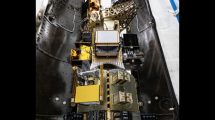 Thuraya, Yahsat’s mobile satellite services subsidiary, has announced that Thuraya MarineStar, its affordable maritime voice solution with advanced two-way tracking and monitoring capabilities has proven to be a bestseller, especially in the Asian maritime markets.
Thuraya, Yahsat’s mobile satellite services subsidiary, has announced that Thuraya MarineStar, its affordable maritime voice solution with advanced two-way tracking and monitoring capabilities has proven to be a bestseller, especially in the Asian maritime markets.
This versatile solution was sold out within a month after its launch and first installations have been made successfully, the company said.
As an entry-level solution, Thuraya MarineStar is built on the same successful voice platform that has sold more than one million Thuraya satellite voice devices. Since it enables tracking and monitoring, in addition to voice communications, vessel operators do not have to invest more in their tracking systems or a brand new tracking application.
Thuraya MarineStar looks to make compliance with national and international fish catch reporting regulations simple by bundling essential elements into one affordable package. Moreover, it supports multiple languages, further cementing its appeal among regional users.
Thuraya MarineStar enables fishing crews to remain connected on their local GSM numbers, even beyond the coastline. The terminal with its IP67 rated antenna can be deployed to perform condition-based on-board monitoring for maintenance activities.
The solution is also available to third-party system integrators who want to integrate their tracking platforms with that of Thuraya. Its terminal has multiple physical interfaces that support external sensors and devices for further customization.
Commenting on the solution, Shawkat Ahmed, Thuraya’s Chief Commercial Officer, said: “When we launched Thuraya MarineStar in late 2019, we were sure we had a winner on our hands. For the cost-conscious user who has to abide by a tight budget, this feature-rich voice solution offers a wide range of value add-ons at an affordable price. We have seen products that had ambitious launches but are still unfortunately out of reach due to the total cost of ownership. Thuraya MarineStar is an unprecedented success because it meets all the essential requirements in terms of connectivity, safety, flexibility and affordability.”












Add Comment